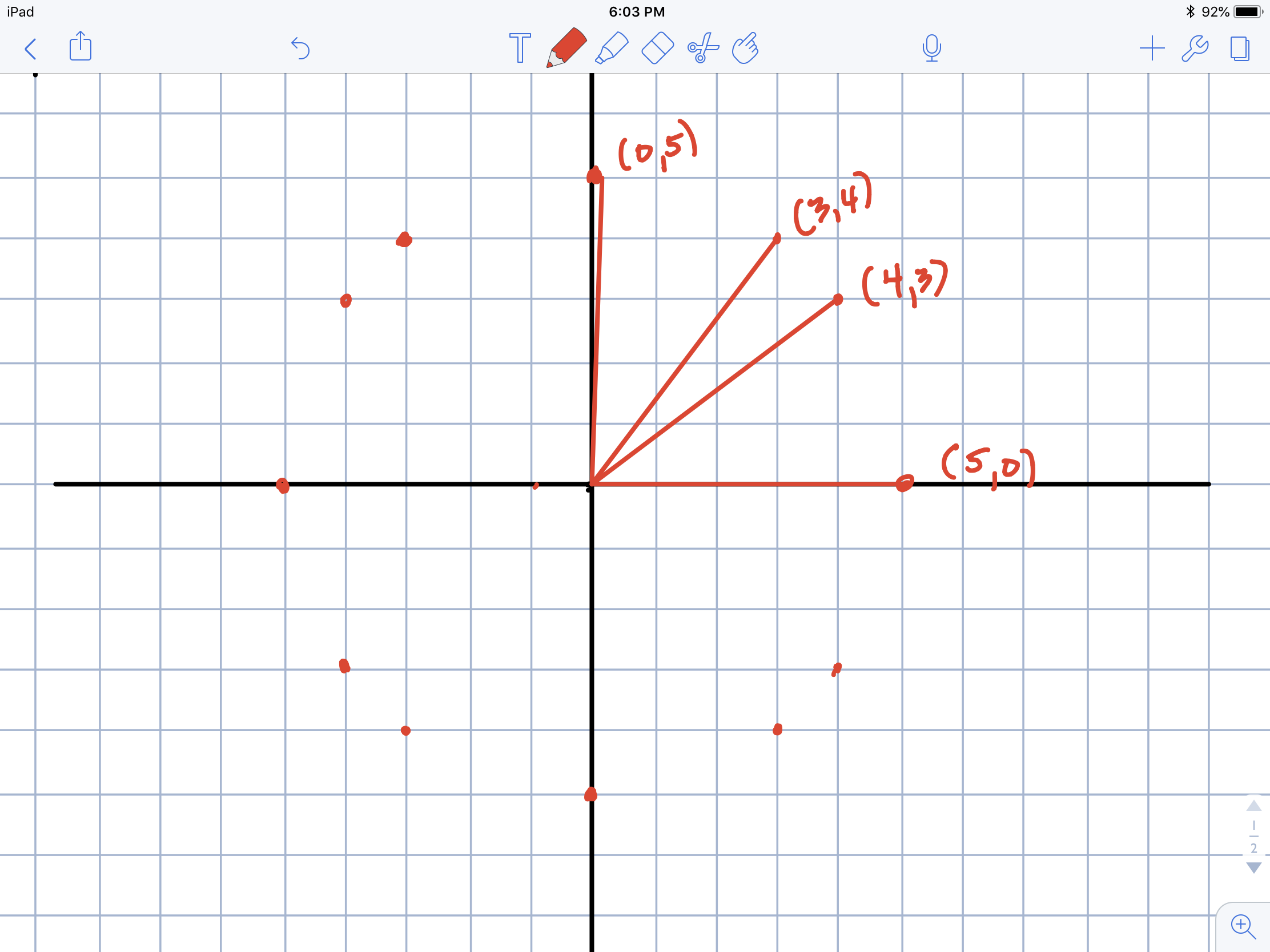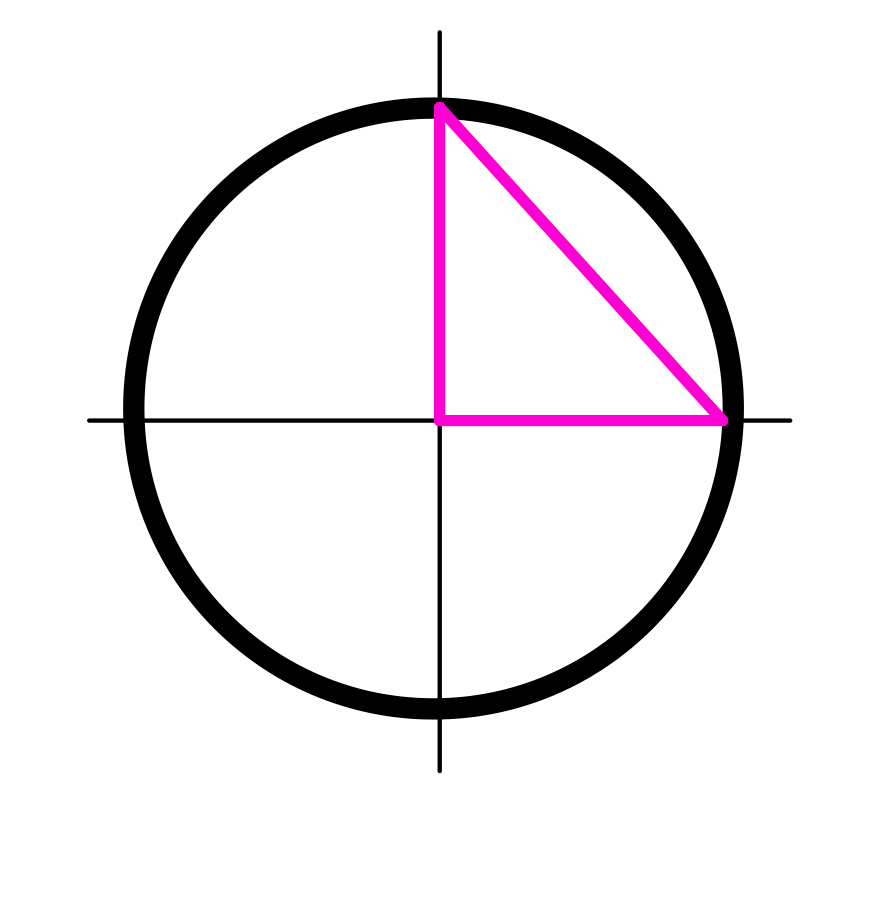In a traditional Geometry text, there is a chapter on circles – usually around 8 or 9 – right? Where they introduce a definition, the equation in a big blue box and students learn how to write equations, find the area, circumference and do some interesting problems negative space if they are lucky. The question then is how are circles connected to the rest of the geometry curriculum? There is so much more that students could be able to see that goes unseen when circles are compartmentalized like this. Circles are often introduced in middle school mathematics classes and by the time they get to high school geometry students have seen area and circumference and perhaps even understand a little bit of the irrationality of pi. What then can a PBL curriculum do to help students understand circle concepts more deeply and in a more connected way?
One of the first types of problems that students are asked to do in the curriculum that I have adapted goes like this:
Find two lattice points that are 5 units away from each other that are not horizontal nor vertical.
This question is clearly asking for two integer-values points on the coordinate plane that are 5 units from each other but students can’t just count them since the distance is diagonal. This is often a difficult idea for students at first who are not comfortable with the idea of Pythagorean distance (see previous post about Pythagorean distance). However, since the beginning of the Math 2 book has so much work with the Pythagorean Theorem, it may be that students are thinking of the distance as the hypotenuse of a right triangle and can think of the 3-4-5 that has shown up in many other problems. It does take some time for students to be able to think of two points like (1,2) and (4,6) as 5 units away from each other.
Students are asked other questions about the configuration of points that meet certain criteria and how it would be represented algebraically. For example:
Describe the set of points that are all 3 units away from the x-axis. How would you describe this configuration in an equation?
This is trying to get students used to visualizing ALL points that satisyfing a given distance condition and when other conic sections are discussed in later courses, they are prepared to be thinking of configurations as a set of points. So finally when they are asked to
Write an equation using the distance formula that says that P=(x,y) is 5 units from (0,0). Plot several such points. What is the configuration of all such points called? How many are lattice points? [See here for a wonderful journal entry by a student on this question].
This question is the first time that circles are actually introduced and the word “circle” isn’t even in the problem. The discussion that occurs can be very deep and interesting (as is what happened when the student who wrote that journal entry presented this problem) or it could be very straightforward and benign. I have been impressed over the year with how well some students understand that a circle must contain points that are all the same distance from the point that is the center. It is introduced with the distance formula because so much of their work to the point has been based on the distance formula.
Students have a great time discussing the number of lattice points that lie on the circle and where they are. If they can harken back to the earlier problem about points that are 5 units apart, they recall the 3-4-5 right triangle easily and get the lattice points in the first quadrant.

Most students can then use their knowledge of transformations and the symmetry that the circle has and find the coordinates of the of the other lattice points. This is also a wonderful conversation about reflection over the axes or origin.
If the student presenting this problem leaves the equation in the distance formula form without simplifying, that’s even better and sets up the next question:
Explain how you could use the Pythagorean Theorem to obtain the same result.
At this point, it is important to connect the distance of five units, the center of the origin and the idea of the radius being a hypotenuse of a right triange with the coordinates the students just found. This will be so important later on when students work with the unit circle in trigonometry for thefirst time.
Ask students to start by drawing right triangles where they think they might be in the circle. Interestingly (and maybe obviously) many of them try to draw it like this (see below) where the right angle is at the origin. This is a great time for a conversation about where the points are that are “5 units away from the origin,” where that distance is, and which point are they saying is on the circle with the right triangle. If some student can connect the idea that the radius is supposed to be the hypotenuse and let another student co me up to the board and make an attempt at the drawing, it is much better than the teacher drawing it for them. As the discussion moves forward and a student can draw the correct right triangle, I have always tried to get other students to draw other triangles. The first that usually happens is that students generally draw the right triangles that have the lattice points as the point on the circle. It takes some time for students to think about the idea that (x, y) can be any point such that x²+y²=25. This takes some time and discussion.
me up to the board and make an attempt at the drawing, it is much better than the teacher drawing it for them. As the discussion moves forward and a student can draw the correct right triangle, I have always tried to get other students to draw other triangles. The first that usually happens is that students generally draw the right triangles that have the lattice points as the point on the circle. It takes some time for students to think about the idea that (x, y) can be any point such that x²+y²=25. This takes some time and discussion.
With a group that is ready, I have also asked students to find the y-coordinates that corresponds to the point on the circle that has the x coordinate that is equal to 1 or 2 and see what they come up with. This is a great time to see if they truly understand what the equation is telling them.
There are many more problems that come after this – some ask for what circles have in common from their equations, some ask for lengths of chords, some are area and circumference problems. I will write another post on how inscribed angles and arcs are introduced but the idea that circles are all connected to the distance formula and the Pythagorean Theorem is a deep one that runs through the whole curriculum and is important for students to see the connections between the right triangles and the circle itself.
